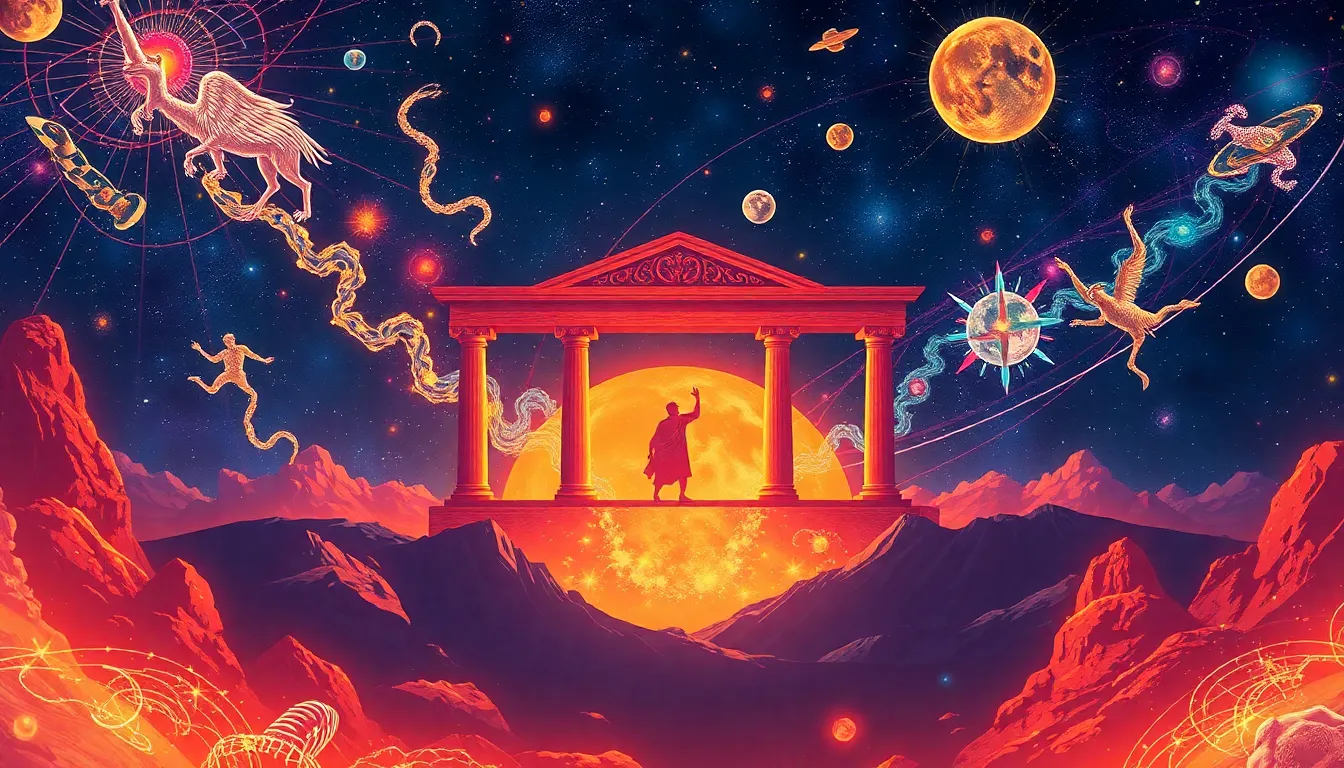Theogony’s Cosmic Order: How the Universe Found Balance
I. Introduction
Hesiod’s “Theogony” is a foundational text of ancient Greek mythology that offers a rich narrative of the origins of the universe and the genealogy of the gods. Written in the 8th century BCE, it serves not only as a mythological account but also as a philosophical exploration of the nature of existence, power, and the cosmos.
In ancient Greek mythology, the concept of cosmic balance is paramount. The interactions among gods, titans, and primordial beings all contribute to a delicate equilibrium that governs the universe. This article seeks to explore the intricate layers of cosmic order as presented in Hesiod’s “Theogony,” examining how chaos transforms into order through the emergence of deities and the establishment of justice.
II. The Concept of Chaos in Theogony
In Hesiod’s work, Chaos is depicted as the primordial void that existed before anything else. It is the initial state of the universe, characterized by a lack of structure and form. From this emptiness, the first deities emerged, setting the stage for creation and the unfolding of cosmic order.
Chaos is not merely a destructive force; rather, it represents potentiality. It is the fertile ground from which all existence springs forth. The role of Chaos is crucial in understanding the transition from disorder to order, as it catalyzes the birth of the first beings that will shape the universe.
III. The Birth of the First Deities
The emergence of primordial beings is a significant moment in “Theogony.” Key figures include:
- Gaea (Earth) – the personification of the Earth, a nurturing figure that provides stability.
- Tartarus – the abyss that lies beneath the Earth, representing depth and the unknown.
- Eros – the embodiment of love and desire, a force that drives creation and connection.
These deities play a vital role in establishing order within the cosmos. Gaea, for instance, not only represents the physical world but also serves as a mother figure to many gods and creatures, fostering life and growth. The interrelationships among these primordial deities lay the groundwork for the complex hierarchy that will develop later in the mythological narrative.
IV. The Rise of the Titans
Following the primordial beings, the Titans emerge as the next generation of deities, representing a new phase in the cosmic hierarchy. They are powerful entities tasked with governing various aspects of the universe. Key Titans include:
- Cronus – the leader of the Titans, known for his eventual overthrow of his father, Uranus.
- Rhea – sister and wife of Cronus, associated with fertility and motherhood.
- Hyperion – personification of light and observation, representing knowledge and clarity.
The Titans contribute to the cosmic order through their dominion over the elements and natural phenomena. However, their reign is marked by conflict, particularly with the Olympians, which leads to a significant struggle for control over the universe.
V. The Olympian Gods and the Establishment of Order
The transition from Titans to Olympians marks a pivotal moment in “Theogony.” The Olympians, led by Zeus, represent a new order characterized by harmony, justice, and balance. Each Olympian god embodies specific aspects of life and the universe, including:
- Zeus – king of the gods, symbolizing authority and order.
- Hera – goddess of marriage and family, representing loyalty and protection.
- Poseidon – god of the sea, embodying the power of nature and its unpredictability.
Zeus, in particular, is a significant figure of balance. He not only dethrones the Titans, establishing a new order, but also enforces justice among gods and mortals alike, ensuring that chaos does not reign again.
VI. Conflicts and Resolutions: The Titanomachy
The Titanomachy, the epic battle between the Titans and the Olympians, serves as a critical event in achieving cosmic balance. This conflict is not merely a struggle for power but also an essential process for establishing order in the universe.
During the Titanomachy, the Olympians, with the support of other entities, confront the Titans in a fierce battle that lasts for ten years. The implications of this war are profound, as it represents the triumph of order over chaos. The aftermath of the conflict results in:
- The imprisonment of the Titans in Tartarus, ensuring that they cannot disrupt the newly established order.
- The ascension of the Olympians, who now govern the cosmos with a renewed sense of purpose.
- The establishment of a balance that integrates various aspects of life, allowing for harmony among gods, mortals, and nature.
VII. Themes of Justice and Retribution
Another essential theme in “Theogony” is the concept of divine justice. The gods operate under a framework of justice that contributes to the cosmic balance. This justice is not arbitrary but is interwoven with the notions of retribution and moral order.
Divine justice serves several purposes:
- It maintains balance among the gods, ensuring that power is not abused.
- It governs the interactions between gods and mortals, reflecting the moral standards of the cosmos.
- It reinforces the consequences of actions, reminding all beings of their responsibilities.
Examples of retribution can be seen in various myths, where gods punish mortals for insolence or hubris, reinforcing the idea that justice is integral to maintaining cosmic equilibrium.
VIII. Conclusion
In conclusion, Hesiod’s “Theogony” presents a rich tapestry of cosmic order that evolves from chaos to a structured universe governed by the principles of justice and balance. The interplay between primordial beings, Titans, and Olympians illustrates the complexities of power, creation, and morality in ancient Greek thought.
The relevance of Hesiod’s work extends beyond the confines of mythology; it invites contemporary reflections on the nature of balance in our world. As we navigate our own lives, the themes of cosmic order remind us of the importance of justice, harmony, and the delicate equilibrium that sustains existence.
Ultimately, the story of “Theogony” serves as a timeless reminder of the struggles and triumphs that shape our understanding of the universe, offering insights that resonate even in modern contexts.




